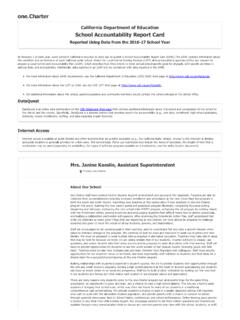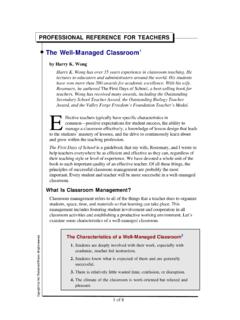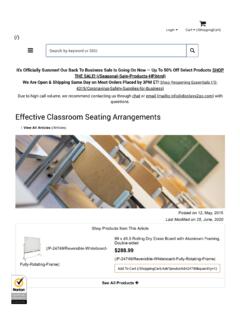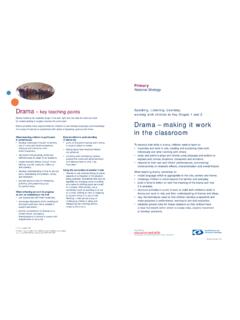Transcription of The 16 Proactive Classroom Management Skills - SJCOE
1 The 16 Proactive Classroom Management Skills to Support Academic Engagement and Reduce Disruptive Behavior Proactive Classroom Management : Proactive Classroom Management (PCM) is about Classroom organization and teacher behavior that are likely to prevent the occurrence of problem behavior. The components of PCM have been established as evidence-based practices to prevent problem behaviors and improve academic performance. It places emphasis on two critical variables that are associated with learning. The first is instructional time, which refers to the amount of opportunity students have to learn, and the second is academic engagement, which represents the amount of time students actually attend to the academic task at hand. Classrooms in which students engage in high rates of unruly behaviors are associated with less instructional time and less academic engagement by students (Sutherland & Wehby, 2001).
2 Thus, the better a teacher is able to manage his/her students, the more time they will have to deliver instruction and the more students will be engaged in learning. effective instructional strategies that produce high student engagement are both critical for learning and for behavior! Classrooms with an emphasis on lecture and independent worksheet completion have been shown to produce high rates of problem behavior, whereas classrooms with more effective strategies and higher meaningful participation in learning produce higher achievement rates and lower rates of defiance and other problem behaviors. The following are the 16 Proactive Classroom Management strategies that have been shown to produce independent improvements in academic engagement and reductions in problem behavior. Classroom behavioral expectations are posted, taught, reviewed and known by every student Strategic establishment of positive relationships with all students in the class (teacher intentionally reaches out to each and every student to get to know them and learn about them).
3 O Simply knowing the name of each student is not enough Organizing a productive Classroom (minimal effort to pay attention, easy flow in/out of room, optimal seating arrangement, limit distractions, etc.). Positive greetings at the door to precorrect and establish positive climate occurs Transitions are taught and managed well Independent seatwork is limited for skill fluency practice and managed effectively when used Competent communication with all students is observed (reprimands/corrective statements are delivered in a non-threatening way). Teaching, modeling, and reinforcing desired prosocial Classroom Skills (following directions the first time, actively listening, waiting patiently, sharing with others, etc.). Teacher mobility and proximity control is used (teacher does not stand in one spot.)
4 Keeps students alert by tracking the teacher and teacher uses proximity control as a method to redirect problem behavior). A motivation system to reward desirable behavior is in place Goal setting and performance feedback is routine Visual schedule of Classroom activities is used Cuing systems to release and regain student attention and foster high student engagement are used Five positive comments, gestures, and interactions to every one correction, reprimand, or negative interaction (5 to 1 ratio). Smiling and being nice! Providing students with numerous opportunities to respond to teacher questions (choral responding, random asking of students, etc.) and interact with classmates over learning content (pair-share).








